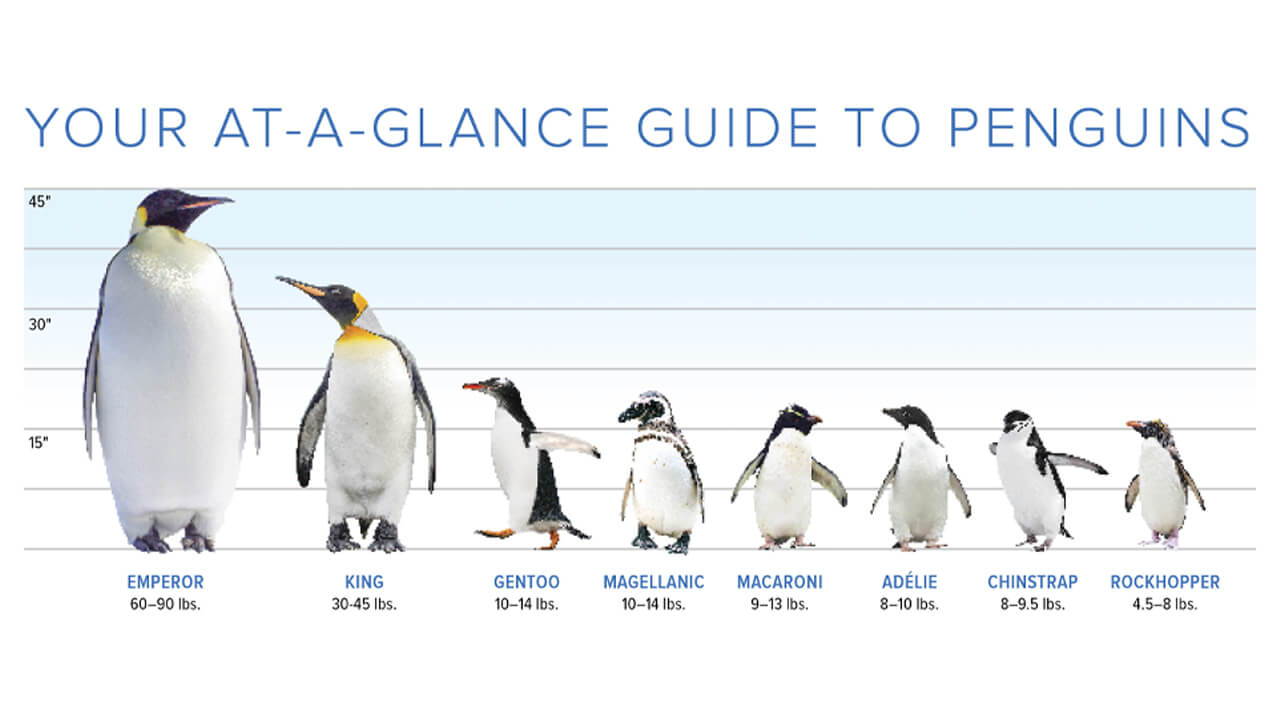

Penguins are a group of aquatic flightless seabirds that make up the scientific order Sphenisciformes and the family Spheniscidae. Penguins have counter-shaded dark, white plumage and flippers for swimming.
Penguins are highly adapted for life in the water and they have counter-shaded dark, white plumage and flippers for swimming. An Antarctic audiovisual adventure with penguins as the main characters.
Penguin Facts And Information

- The name “Penguin” comes from the Welsh, “Pen”, which means head, and “Gwyn”, which means white.
- Penguin babies, called “chicks” or “nestlings.”
- A group of baby penguins called “crèche.”
- Penguins mate for life.
- Penguins are flightless seabirds that are built to “fly” through the water.
- Penguins are birds that can’t fly.
- Penguins don’t live near freshwater.
- There can be up to 100 million penguins in the world.
- They spend half of their lives on land and half in the oceans.
- There are 18 species of penguin, each of which is slightly different. All of the species live in the Southern hemisphere. Most of life at the South Pole in Antarctica. Some can be found on the coasts of Australia, Africa, New Zealand, South America, and the Galapagos Islands.
- Galápagos penguin is only one species, found north of the equator.
- Some penguins, such as the Galapagos penguins, manages to settle in warm temperatures.
- The tallest penguin is the Emperor penguin at more than 1m in height, whereas the smallest penguin in Galapagos penguin which is height is 49 – 53 cm.
- The Emperor penguins are the only species that nests and breeds in Antarctica during the frigid winter.

- Penguins have white and black feathers, when they walk they are waddle.
- They’re from the scientific order “Sphenisciformes” and the family “Spheniscidae”.
- Penguins are warm-blooded and have a normal body temperature of around 37 °C (100 °F).
- The penguin can hold its breath underwater for about 6 minutes.
- Penguins don’t live near freshwater, at least anything that isn’t frozen. Instead, they drink salt water.
- Penguins rub oil from a gland on their feathers to help make them windproof as well waterproof.
- Leopard seals are the main threat to penguins, but sea lions and killer whales are also predators. Some large seabirds, such as the Australian eagle and Skua, also threaten the penguin.
Penguins also have many on-land terrestrial predators, including cats, ferrets, foxes, lizards, mice, and snakes. - To keep each other warm, groups of penguins huddled each other shoulder to shoulder and strengthen their body wings. Up to 5,000 penguins will connect together to warm each other up.
- Penguins can be at risk from water pollution, oil spills, and over-harvesting in the ocean.

- Penguins are very strong birds that can fly into the air at a height of 6 feet.
- Penguins spend most of their time in the water looking for food.
- Some penguins travel from 15 to 900 km in search of food.
- They’re in the water at home when they dive, jump, play, spin, and searching for food.
- Penguins eat seafood. Their main diet is fish, but they also eat squid, small shrimp know as “krill” and “crustaceans”.
- Under the skin of penguins, there is a layer of fat like whales called “blubber”.
- Penguins have torpedo-shaped bodies. This shape allows them to go through water at a speed of 40 kilometers (25 miles) per hour. However, they can’t swim backward.
- During the mating season, penguins move to special nesting areas on the shore. The area where penguins together, nest, and raise their chicks are known as a rookery.
- The penguins will build their nests with everything that is available, even stones and rocks.
- When the baby penguin hatches, it immediately begins calling for its parents to recognize its voice.
- As soon as the egg is laid (the female penguin lays one or two eggs at a time), the female drags for dinner and leaves the male to look at the nest. When the female returns (it may take up to two weeks for her to return), the man goes out for food, leaving the female with eggs.
- All the baby penguins in the colony will remain together until their parents return. When the parents return home, they recognize their chick again by the sound of its voice.

- Penguins are difficult to stay healthy in zoos due to the lack of biological protection against bacteria/germs found outside the cold Antarctic.
- Penguins also have backward-facing bristles on the tongues, which helps slippery seafood to slip away.
- Penguins can eat up to 3,500 metric tons of squid, 115,000 metric tons of fish, and 1,500,000 metric tons of krill per year.
- Survival is one of the main concerns for penguins. They make sure that there are no predators in their homes. It is essential for them to find a place where they will have sufficient food and shelter. They settle in a place that depends on the temperature of the climate. The water temperature must be at least 10 degrees Celsius or colder than their body temperature.
- Penguins also practice an annual fasting period during the breeding, molting, and preparedness for plumage feathers which takes 54 to 120 days but depending on the species.
